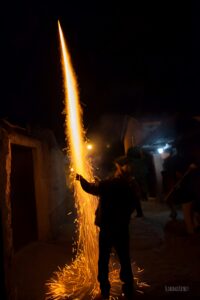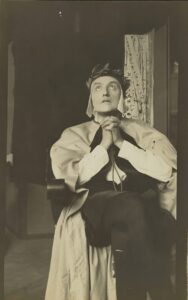Tumblr post by user Florence Leyret Photography captioned a post with the last line of Paradiso —Florence Leyret, “The love that moves the sun and the other stars…,” Tumblr, February 4, 2017 (retrieved February 29, 2024)
“Models and the Making of Violet Oakley’s Dante Window”
“The papers of Violet Oakley contain primary sources that reveal some of what she required of her models. She called on her friend, the illustrator Mills Thompson, as she prepared the stained glass Dante Window. (The Smithsonian American Art Museum owns a scale model; the work is in the Apostolic Nunciature of the Holy See to the United States.) Draped in cloth resembling Renaissance garb, donning a laurel wreath, and wearing a prosthetic nose, Thompson posed for a series of reference photographs that Oakley used in creating the window which was based on the Dante Alighieri’s fourteenth-century poem The Divine Comedy.
[. . .]
“Like the epic poem, the window is divided into three parts with four medallions each: the left panel represents the Inferno, (meant to be read from top to bottom), the right panel, Purgatorio, (read from the bottom), and the center section, Paradiso (also read from the bottom). In this group of twenty photographs, an animated Thompson personifies the character of Dante as he ponders, prays, attempts to ward off beasts, travels through Hell and Purgatory with Virgil, and ascends to Heaven with Beatrice. (Henrietta Cozens, who likely posed as Virgil for the image in medallion two of the Purgatorio panel, is not quite as vigorous in her expression.)” —Elizabeth Botten, “Models and the Making of Violet Oakley’s Dante Window”, Smithsonian Blog, June 17, 2014 (retrieved February 29, 2024)
Emira Mir on Instagram: Beauty Awakens the Soul to Act” (2022)
Pakistani pop singer Emira Mir posted this image to her Instagram with the comment “Beauty awakens the soul to act,” a loose (but standardized) translation of Purgatorio 18.21: Dante’s “tosto che dal piacere in atto [l’animo] è desto.”
See other examples of uses of the standardized English verse here.
Aïda Muluneh, The 99 Series (2014)

“…I painted her body white because for me, living in this city we call Addis Ababa, we don’t need to fantasize about going to the Inferno—I have seen and experienced enough things to really make me question humanity. I have realized that in order to get ahead here, many people wear masks in order to protect their future. But while doing this, the reality is that I have seen the various atrocities and the great lengths that many will go to in order to maintain their success. So with that in mind, for me the red hands symbolize the guilt associated with the thirst for upward mobility. The cloth wrapped around Salem’s body is specifically from the southern region of Ethiopia, which has endured several centuries of oppression, slavery, and so forth. For the background color, I chose the off-grey because it reminds me of dirty snow; this reminds me of my childhood growing up in Canada, in the midst of the bitter cold, and also the challenges that I faced being an African immigrant in an all-white community.”
Retrieved from The Divine Comedy: Heaven, Purgatory, and Hell Revisited by Contemporary African Artists by Simon Njami.
For more information on The 99 Series, visit Muluneh’s website here.
Don Thompson’s “The Wood of Suicides”
“The Wood of Suicides. Canto XIII, Inferno. These images were taken adjacent to campus, after the Malibu fires.” [. . .] –Don Thompson, d.t. pepperdine, October 2007.
- 1
- 2
- 3
- 4
- Next Page »





